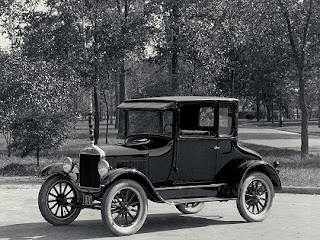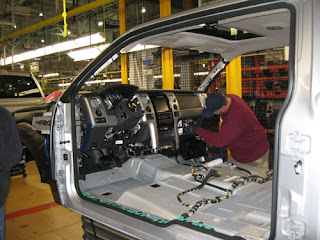 |
| The back of the Michigan state quarter. Perhaps you have a Michigan quarter in your pocket. |
Michigan is a state that borders Canada, and it is divided
into two parts: the Upper Peninsula and the Lower Peninsula. Some people think
that the Lower Peninsula of Michigan looks like a mitten. Michigan is the only
state to border four of the Great Lakes--Lake Superior, Lake
Michigan, Lake Huron, and Lake Erie. Because of this, only one state has more shoreline than Michigan, and that state is Alaska. You can see how Michigan touches four Great Lakes in the photo of the quarter above.
 |
| You can see the Upper Peninsula and the Lower Peninsula on this map. Locals call them the UP and the LP, and I have seen signs referring to the LP as The Mitten. |
Detroit, the state’s largest city with a population of more
than 5,000,000, is known as the Motor City because it serves as the center for
the manufacturing of American automobiles. Cars made in Detroit are shipped all
over the country. The “big three” automakers are General Motors, Ford Motor
Company, and Chrysler; all three are headquartered in Detroit. The Detroit
River connects the Great Lakes to the St. Lawrence Seaway making Detroit an
important port for importing and exporting goods and a leader in global trade.
Think how your life would change if there were no
automobiles, trucks, buses or other machines powered by internal combustion engines. How would you
get to school? How much smaller would your world become? While humans have
thrived on Earth for thousands of years, automobiles have only been around for
a little more than a hundred. And the earliest cars bear little resemblance to
those we drive today.
One
hundred and thirty-three years ago, a young man made his way to Detroit to
accept an apprenticeship as a machinist because he did not want to be a farmer like his father. By 1888 he was running a sawmill. A
few years later this young man became an engineer and began tinkering with internal
combustion engines. By 1896 he had created a self-propelled vehicle
called a Quadricycle. Open-air with no protection from the weather, this early
automobile was steered with a rudder and would only go forward. So, who was
this industrious man who eventually led the way in the mass production of cars?
Henry Ford. While he wasn’t the first to create a gasoline powered
self-propelled vehicle, he was a pioneer in the automotive industry who
established The Ford Motor Company.
Henry Ford was not a man to give up easily. His first company, Detroit Auto Works, quickly went bust. In 1901 he opened a second business, Henry Ford Company, but it lasted less than five months. Ford made a new attempt in 1903 establishing the Ford Motor Company. Success at last! The company continues to this day. And as it turned out, Henry Ford revolutionized not only the automotive industry, but all of global manufacturing.
 |
| Ford's earliest car, the Quadricycle. Hey! Where's the steering wheel? |
 |
| Model T Ford, often called "The Tin Lizzie" |
By
1918 half of all cars on the road were Fords—Model T Fords. And Henry Ford
bragged that you could have one in any color you liked as long as it was black.
So, how did Henry Ford capture the automobile market? He did it largely by
being smarter than his competition. He opened a large factory and created an
assembly line that continuously moved. Formerly, cars were built one at a time,
a labor-intensive process. It took a team of men twelve hours to assemble a Model T. Then, Ford figured out how to speed things up. His
factory workers each had a station. They stayed in one place and added pieces to the car under
construction as it moved past them on a moving conveyor. All car parts moved on overhead belts so that workers could easily access them. Everything was
managed for the greatest efficiency. With this new system in place, the time to build a Model T dropped to 93 minutes. Other factories copied Ford’s breakthrough
resulting in the revolutionizing of the entire automotive industry. This cost-effective
method is still used today.
Then, Ford did something surprising. He advertized that he was doubling workers' wages to five dollars a day, a large amount of money at the time. Men flocked from all over the country to gain employment. And for the first time, they earned enough money to buy one of the cars they helped build. At the time, a new Model T cost about $250, a lot of money back then. By the late 1920s Ford Motors was in full production in a huge factory with a staff of 100,000. At one time, Ford Motors was the largest automobile
manufacturer in the entire world!
Have you ever wanted to see a truck built? What do you think a truck factory looks like? When I visited the Ford Rouge Factory to watch workers--both men and women--create trucks, I found it to be one of the most interesting places I have ever visited. The Ford F150 truck factory is a modern and clean facility and I couldn't help but wonder what Henry Ford would think if he could see the place.
 |
| A Ford F150 being built |
For
starters, Ford Motors works hard to be environmentally friendly. The modern
facility has a 10.4-acre green roof, the largest such roof in the world. What
is a green roof? It is a roof covered with plants! This type of roof has many
benefits. For starters, it lasts twice as long as an ordinary roof. In
addition, it creates a lovely habitat for birds and butterflies. It lowers the
summer temperature by 10 degrees, and can hold 4.5 million gallons of rainwater,
enough to fill six Olympic-sized swimming pools. The roof changes colors throughout
the year. It is green in spring, covered with flowers in the summer, and bronze
in the fall.
 |
| Here you can see the living roof of the Ford Rouge Factory. |
The
Ford F150 factory has two robots, one for mounting moon roofs and the other for
final inspection of the welded seams. Humans do the rest of the work assembling
the trucks by hand. One thousand workers are spread along the four miles of
assembly lines. Each worker is assigned to one of thirty stations in the build
line. These include door latch installation, tail gate assembly, mirror
installation, box build, and assembly of various components such as headliners,
instrument panel, dashboard, airbags, steering wheels and so on. Workers select
the correct parts, based on the truck being built. Nine different truck models
on three different chassis are produced in the Rough factory. If your family owns a Ford F150 truck, it is likely that it was built in the factory I visited.
 |
| A completed Ford F150 truck |



2 comments:
Detroit's population hasn't been close to 5,000,000 for a long time. It is now about 705,585. I was born there and visit frequently.
Chrysler Motors Corporate Headquarters is in Charlotte, North Carolina
Post a Comment